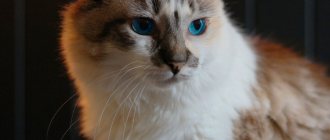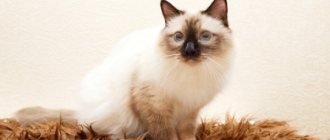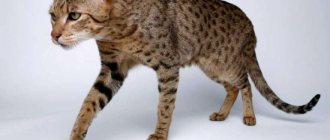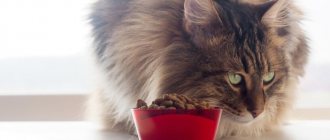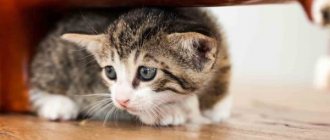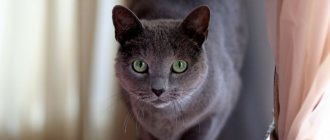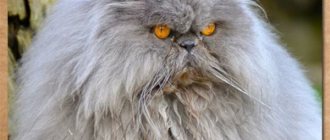A cat with a fluffy Persian “fur coat” of the color of a Siamese aristocrat, a soft, almost angelic character and an innate sense of dignity—is it just an amazing hybrid or a dream of a cat lover-aesthete? No less than sacred Burma . The famous fashion designer Karl Lagerfeld discovered his muse in one of the cats of the sacred Burmese breed. What is the animal that is being looked after by three specially trained maids? What secret does the sacred Burmese cat hide?
Description of the Burmese cat breed
Popularity 57th place among 86 cat breeds
Lifespan:
14-16 years old
Height:
from 28 to 32 cm
Country of origin:
Myanmar
Average price:
30-40 thousand rubles
Weight:
from 4.5 to 8 kg
Latest articles Cat care
How to trim a cat's claws correctly and easily 01/28/2022 129 0 0
Dog health
How to do an ultrasound for dogs: preparation and procedure 01/28/2022 59 0 0
Coat
The fur of Burmese cats is fluffy and quite long. At the same time, it is very soft, silky, and easy to care for, since tangles do not appear in it.
Around the neck, the fur is much longer and more luxuriant, forming a so-called “jabot”.
In the belly area the coat is slightly wavy. The tail is very fluffy, the hair towards the end of the tail is longer than at its beginning.
On the face, the hair, like that of all cats, is very short, but closer to the body it becomes more luxuriant.
Key facts
The official name of the breed is the Burmese cat, or sacred Burma. The name is based on the country of origin - a state in Southeast Asia called Myanmar. Burma is its former name, popular among foreigners and lasting until 1989. In English pronunciation this word sounds like “Burma”, which often misleads people. The Burmese and Burmese cat breeds do share a common country of origin, but have completely different appearances. The description of the Burmese cat includes having long hair and a color-point coat, while the Burmese's coat is short and darker.
The average lifespan of a Burmese cat is 15 years. She has good health and a balanced character. The greatest friendliness is characteristic of males. They quickly find a common language with other animals, enjoy playing with children and are not afraid of strangers.
Among the key characteristics of the Burmese cat breed, it is important to note extreme curiosity and perseverance. These animals know how to achieve their desires, so sometimes they are too annoying.
One of the most famous Burmas is the Choupette cat, which belonged to the German fashion designer Karl Lagerfeld. After the owner's death, she inherited $200 million.
Coat color
The Burmese cat wears color point colors (translated into Russian as “colored dot”, “colored mark”). It is vaguely similar to the color of Siamese and Himalayan cats.
The main color of the fur is white, cream. The paws, muzzle and tail are highlighted in a contrasting color. White “gloves” are retained on all paws, which should be symmetrical on the front and hind paws. Paw pads are brown, dark brown, pink.
Interesting!
Breeders call this color multi-temperature. The recessive gene “CS” is involved in the formation of color. It is active in the coldest areas of the body. These are color points of a dark shade. The photographs perfectly convey temperature zoning.
Blue point
The blue Burmese cat is common and is considered a classic. The blue cat was the first of the breed. Her eyes are lighter compared to other representatives of the Burmese cat breed. The marks are highlighted in a cold, blue color with a gray tint. An excellent example is shown in the photo.
Interesting!
The Blue Burmese cat is very similar to the Thai breed, which is why they are often confused.
Dark brown point (seal point)
The color shown in the photo is considered a classic. The markings are dark brown or chocolate-colored to contrast with the light beige coat. The brown Burmese cat has deep dark blue eyes.
Lilac point
In many ways, the descriptions of the colors agree with each other. The only difference is the color of the points. In the lilac color, they are painted in a gray-purple hue. The nose is highlighted in a darker color, which is clearly visible in the photo. The lower parts of the limbs remain white.
Interesting!
An ancient legend says that special color marks appeared on the animal’s fur for a reason. This makes it easier for the patron goddess to protect her charges, even when she sees them from behind.
Chocolate point
The chocolate-colored Burmese cat has bright blue eyes, which even pictures convey. The tail is painted the same color as the “mask” on the muzzle, or highlighted with a shade of chocolate. The main coat color is milky, ivory. The paws are decorated with snow-white “gloves”.
Cream point
This Burmese cat has a white base coat. Let's say a cream shade or ivory color. The markings are highlighted with a creamy tint. Sometimes it blends in with the fur, as in the photo. The tail may be brighter.
Red point
The Burmese cat can even be red. The points are colored in a delicate carrot shade. The muzzle, ears, tail and paws stand out. The completion of the limbs remains perfectly white. Eye color is blue. The red-haired beauty rarely appears in a litter, so it is highly valued.
Tortie point
The points are tortoiseshell in color. 2-3 shades appear on the face, like the Burmese cat in the photo. There are spots of red, chocolate, and cream colors. Points on the paws can follow the palette. Less often they are painted the same color.
Tabby point
Distinguished by striped points. They can be red, gray, chocolate. The pattern is especially pronounced on the muzzle and paws. The ears and tail are highlighted in a dark shade. The nose may have a gray or pinkish color. Eyes remain blue from birth.
Interesting!
With the naked eye you can see the similarities between the Burmese and the Neva Masquerade breed. They have a characteristic Siamese coloration. However, the Neva Masquerade has green or gray eyes. Also, the Neva Masquerade breed is less patient and kind.
History of the origin of the Burmese cat
The exact country of origin of the breed is unknown, since the Burmese received its first official recognition in France in 1925. Felinologists suggest that the animals were brought from Myanmar by an American billionaire who took a cruise to eastern countries in 1919.
The man gave a considerable part of his fortune for two kittens, but only the girl survived the journey. It was she who became the founder of the European line. In the second half of the 20th century, furry animals were recognized by all felinological organizations.
It is believed that the appearance of the cats was achieved through matings of Siamese and Persians. Residents of Myanmar claim that mentions of these cats date back to ancient times and contain many interesting facts. One of them explains why animals are called sacred.
At the temples of the goddess Tsun Huan Ce, the guide of souls in the afterlife, with the death of some monks, black and white cats with golden eyes appeared. Buddhists believed that these were messengers of the goddess who had arrived to protect the temple, and treated them with special respect. One day, during an attack by robbers, one of the cats named Singh came to the defense of the monks. His fur glowed with a golden glow and his eyes changed color to bright blue. This scared off the bandits and helped defend the temple.
Breed characteristics
COUNTRY OF ORIGIN
Burma
EXTERIOR
A stocky cat with gorgeous fur. An elongated, strong body with good muscles and strong bones. The head is wide and slightly rounded, with a straight nose, full cheeks and a strong chin. The ears are wide at the base. The eyes are almost round, widely spaced, and always blue. Legs of medium length, muscular; paws are large and round. The tail is of medium length.
SIZE
Medium, closer to large.
COLOR
Beautiful medium-length silky coat, collar around the neck. Different felinological organizations allow different color options. Traditional colors are point, chocolate point, blue point, lil point. White “gloves” are required, as are white markings on the hind legs that resemble shoelaces.
PECULIARITIES
Gentle, quiet, pliable, loving cat.
What does a Burmese cat look like?
A photo of a Burmese cat shows an amazing resemblance to Siamese and Himalayans. This breed is suitable for those who are delighted with the Siamese color and Himalayan coat, but consider a thin body or flattened muzzle not beautiful enough. Along with its attractive appearance, a bonus to the Burmese is its docile and friendly character. The weight of these animals is 4-6 kg, and their height at the withers is about 30 cm. Boys are always larger than girls, so they usually weigh at least 5 kg.
Muzzle
The breed is characterized by a rounded head. Its width is slightly shorter than its length. The animal has a slightly convex forehead, rounded cheeks and a strong chin. According to the standards, 2 varieties of Burmese cats are allowed: with a pronounced stop for TICA and the absence of a transition from the muzzle to the “Roman” nose for FIFe. The calling card of the breed is its round, expressive sapphire-colored eyes. Their color varies from light blue to deep blue. Unlike other cats, blue eyes do not have a negative effect on hearing. The small ears are slightly tilted forward, rounded at the tips and pubescent on the inside.
Possible defects include squint, a different eye color, or the presence of a silvery sheen in them. An animal with such an appearance will be classified as a pet class and will not be allowed for breeding.
Body type
The head is located on a slightly muscular and wide neck. The body of the Burmese is squat and elongated, with powerful bones. The hind and forelimbs are thick and muscular. They end in round and strong paws with tufts of hairs between the toes. The raised tail is pubescent. Its knobbiness or curvature is unacceptable.
Coat and color
The animal's fur has no undercoat and resembles silk. On the belly, the hairs curl into a light wave, and on the neck they grow into a luxurious mane. The main color of the Burmese cat is color point. Unlike Siamese, the standard of this breed allows for all possible markings: chocolate, lilac, gray, red. The color of most of the coat varies from white to cream.
The dark markings present on the tail, ears, limbs and muzzle match the appearance of the Siamese. A distinctive feature of Burmese is considered to be white “socks” on all four paws. Their absence will result in disqualification. Defects also include points on the light parts of the coat and light marks on the points.
Education and physical activity
Burmese cats are endowed with high intelligence and excellent memory. They easily get used to the rules established in the owner's house and get accustomed to the tray and scratching post.
Burmese cats do not refuse to play and walk outside, but they can do without them. Unlike most other breeds, they do not land well. Therefore, sacred Burmese cats must be protected from jumping and accidental falls from heights.
Personality of the Burmese cat
If we talk about who is suitable for Burma, then it will be the elderly and owners with disabilities. These animals don't like noise. Loud screams of small children or frequent parties frighten them, negatively affecting their psyche. This breed also has an intolerant attitude towards loneliness. They quickly become attached to their owners and enjoy sitting in their arms.
The character of the Burmese cat is called balanced. She is characterized by playfulness and high intelligence. Despite the increased activity, the animal always keeps itself within certain limits. A furry pet will never offend a child, so it can suffer if handled incorrectly. She gets along well with other pets, but can become jealous if she notices that a person is paying more attention to them. Burmese owners claim that their pets can read their thoughts. Initially, this feature was noticed by Buddhist monks, who nicknamed the animals “the eye of heaven” for their piercing gaze.
One of the disadvantages of the breed is excessive obsession. It manifests itself when an animal wants something very badly. Excessive assertiveness can even make you angry, but you have to put up with this behavior. Your negative reaction or lack thereof will only offend Burma. In most cases, manipulation skills are used appropriately when the owner is in a good mood.
Pros and cons of the breed
A description of the main characteristics will help you finally decide on the choice of breed.
Pros of Burmese cats:
- cleanliness;
- calm behavior;
- lack of aggression;
- positive attitude towards people, children, animals;
- easy care;
- elegant and expressive appearance, as confirmed by the pictures;
- empathy - animals quickly read the mood of the owner, support him if he is feeling bad, and rejoice with him;
- fast learner.
Disadvantages of the breed:
- are expensive;
- cannot be alone;
- can be overly curious and intrusive.
Despite the disadvantages, the pros always outweigh the choice of this lovely breed.
Raising a Burmese cat
Many owners do not understand how to stop their pets from scratching and chewing their hands. This problem often occurs due to improper training and games. The owner's hands are made for affection. They give food and should never hurt.
Also try not to use them for gaming. The exception is playing under a blanket. Most cats are convinced that they are hunting the “duvet monster” and not the owner.
When raising a Burmese cat, use punishment based on its character. The most effective method of punishment is ignoring. The main thing here is to make sure that the pet understands the reason for such treatment. If he went to the toilet past the tray while you were at work, then any punishment is already meaningless. In such a situation, the lack of affection will frighten the animal, which is detrimental to the psyche.
Another effective method of punishment is a stream of water. Use it when teaching prohibition commands. Burms are smart creatures. They will quickly realize the relationship and begin to stop their actions at the word “no”, without waiting for being sprayed with water.
Don't try to create a trained animal by doing the same thing as dogs. Your task is to correct behavior and get a well-mannered pet who is familiar with the basic prohibitions in your home.
Burma and children
Burmese kittens get along well with children, especially if the babies are raised together from diapers. You can leave your pet with your child without fear, knowing that it will not bite or release its claws.
Usually Burmese people patiently endure the not very skillful caresses of babies. First, you should still talk to the child, explaining that the cat is a living creature and you need to be careful with it.
Older children who love and know how to handle animals tend to find contact with Sacred Burma. Children and animals often become best friends and enjoy playing together.
Burmese cat health
Burms are long-lived cats. One of them, Lady Catalina from Australia, is immortalized on the pages of the Guinness Book of Records: her life expectancy was 35 years.
Thanks to careful selection, the health of the Burmese cat turned out to be quite strong. With regular visits to the veterinarian, timely treatment for parasites and the availability of all necessary vaccinations, Burmese live longer than other breeds.
Possible diseases
Hereditary diseases of Burmese include hypertrophic cardiomyopathy, corneal dermoids and vestibular disorders. If detected early, they are all treatable.
Heart problems are easily recognized by shortness of breath and coughing that appears immediately after active games. The presence of a dermoid (a sac-like tumor on the white of the eye) is visible to the naked eye. Coordination problems manifest themselves in unsteady gait and other balance problems.
Reproductive health
To obtain offspring, only purebred partners with pedigrees are used. Mating with other breeds, mestizos and representatives of the pet class is strictly prohibited. Due to the small number of representatives, felinological organizations strictly control all matings and can punish violators with a fine.
Pregnancy is a difficult test for the body. Frequent births, more than 3 times in 2 years, are prohibited. For Burmese cats, the conditions are less strict - they can mate twice a month.
Burmese are record holders not only in age, but also in the number of newborns. They usually give birth to up to 10 kittens, but one representative managed to give birth to as many as 19 babies. Coping with such a huge offspring is not so easy, so veterinarians recommend not torturing yourself or the animals. Immediately after the appearance of sexual activity, pets can be scheduled for sterilization or castration. For representatives of the pet class, this is the most reasonable solution, since they are not allowed for breeding.
Diseases and life expectancy
Burmese cats live on average from 10 to 15 years, there are also long-livers, over 20 years. This breed has a congenital predisposition to certain diseases:
- Hypertrophic cardiomyopathy - occurs as a result of inheritance of the disease in an autosomal dominant manner. It is characterized by myocardial damage with the gradual formation of heart failure, thrombus formation and, as a result, death.
- Kidney disease - the most commonly diagnosed disease is urolithiasis.
- Spongiform encephalopathy is a degenerative change in the substance of the brain, in which neurological pathologies are observed, paresis and paralysis of the limbs are possible.
- Corneal dermoid is a tumor that occurs as a result of impaired tissue embryogenesis. The disease manifests itself at a young age, with a tumor forming on the mucous membrane of the eyes, which looks similar to the skin. It can be treated through surgery and does not pose a danger to the animal if promptly contacted by a specialist.
Features of feeding and diet
The cost of keeping a Burmese is quite high, since it does not favor dry food and canned food. Natural feeding is often more expensive, since in addition to food you have to buy vitamins. It is also worth considering the fastidiousness of the animal. Before you understand what to feed your pet, you will have to sweat in trying to recognize his favorite dish.
Of course, there are advantages to owning a Burma. She never suffers from obesity, because she knows her norm. Purebred pets will not eat everything that is poured into a bowl if the feeling of fullness has already set in. When preparing your diet, follow the general recommendations:
- Choose lean meats: chicken, rabbit, turkey. Pork and lamb are harmful to the kidneys and liver. Protein should form the basis of the diet.
- Use natural fermented milk products. Milk can only be given to kittens. After 1 year of age, all adult animals develop lactose intolerance.
- Supplement your main diet with a small amount of cereals and vegetables.
- Avoid any products that contain natural or artificial colors. They can change the color of the fur coat to a darker shade.
Feed adult pets twice a day, leaving no more than 250 g of food at one time, and even less dry food. It is enough for kittens to give 150 g of food 4-5 times a day. Calculating portions is necessary to ensure that the food does not spoil in the bowl. Remember that natural products are removed immediately after feeding.
Vaccinations and antiparasitic treatment
To prevent viral and infectious diseases, the sacred Burmese cat is regularly vaccinated against rhinotracheitis, calcivirosis and panleukopenia. The first vaccination is given to the animal at the age of 7-8 weeks.
After 4 weeks, the Burmese kitten is re-vaccinated against the same diseases and against rabies. Subsequently, the cat is vaccinated once a year.
To protect the sacred Burma from diseases carried by parasites, it is periodically treated against fleas and worms. Anthelmintic drugs are given to the cat twice a year with mandatory repetition after 10-14 days.
To combat fleas, drops and shampoos are used. And if a Burmese cat goes outside even occasionally, it is additionally protected with an anti-parasitic collar.
Care and maintenance
The birthplace of Burma is one of the hottest countries. When purchasing a representative of this breed, please note that temperatures below 20°C are unacceptable for him. The fluffy pet easily catches colds in drafts and prefers to sleep under a blanket even in summer.
Caring for and maintaining a Burmese cat involves creating comfortable and safe conditions. The animal must not be taken outside, kept in a pen or small cage, or deprived of human contact.
The Burmese are afraid of precipitation, and winter is the most dangerous time of the year for them. Also, future owners should keep in mind the special property of the vestibular apparatus of these cats. Landing on four paws is impossible for them. If an animal falls out of a window from the second or even the first floor, it can be seriously injured, so installing an anti-cat device is a prerequisite.
If you are often away from home, then be sure to take care of interactive toys. Intellectual games are especially loved by this breed and help distract them in lonely hours. Although a more adequate option would be to buy another pet.
For the health and hygiene of your furry pet, follow these recommendations:
- Brush it twice a week with a sparse comb. Due to the absence of undercoat, shedding in long-haired pets is weakly expressed, but the frequency of brushing during this period still needs to be increased.
- Clean your ears twice a month to remove dirt and wax from your ears and remove any discharge that accumulates in the corners of your eyes daily. Also, do not forget about monthly brushing of your teeth, which prevents the development of oral pathologies.
- Carry out washing only when heavily soiled, trying to accustom the animal to this procedure from early childhood.
- Trim the nails as they grow if the scratching post does not cope with this task.
Another important need for caring for your Burmese is keeping it clean. An animal may refuse to eat from dirty feeders or go to a tray with stale litter.
Character and behavior
The sacred Burmese cat is an amazingly intelligent animal. Any owner will tell you that his pet understands him perfectly and knows how to communicate with just a glance. No wonder, apparently, that Buddhist monks nicknamed them “the eye of heaven.” This breed seems to maintain an ideal balance: they are not lazy, but not hectic, they know how to play, but they also know how to contemplate. Smooth movements, unhurried gait, poise, friendliness to everyone without exception - these are the qualities and features inherent in the Burma. And, the most interesting thing is that in cats they appear more clearly than in females.
Burmese cats are very careful when playing, especially with children. Even in the midst of running or hunting, they do not allow themselves to extend their claws or show their teeth to humans. If the latter allows himself too much - tries to pull her tail, for example - they will immediately stop the game and, proudly raising their heads, retreat away.
They get along easily with other pets. With cats of any breed - easily, with dogs - they behave more warily, but are not afraid. However, she is extremely jealous. If the beloved owner pays more attention to someone else, he will clearly express his dissatisfaction and may even be offended.
They do not tolerate separation well, so if you are planning long business trips and travel, do not get this breed. The best nanny cannot replace your loved one.
It is worth mentioning the disadvantages of the breed. Burma is characterized by mood swings, sometimes abrupt and not always understandable to humans. At times, the Burmese cat can be very intrusive and curious. If you set a goal for yourself, there will be no limits to its stubbornness. And if the owner cannot curb his anger at this moment, he will try to raise his voice, roughly grab her or spank her - he may even show aggressiveness.
Which cat's smile walked on its own?
SiameseCheshire
However, this does not happen very often. If the owner creates comfortable conditions for the cat (changes the tray on time, does not forget to feed, buys a play complex and a house for sleeping), then the animal will have practically no reason for dissatisfaction.
Tips for choosing a kitten
One of the peculiarities of Burmese kittens is the absence of a characteristic color until a certain age. Babies are born completely white. The first marks appear only at 1-2 months of life, which is actively used by scammers. You will be able to find out the exact color of your future pet only after 1.5 years.
For safety reasons, choose a certified nursery that is ready to provide a mandatory set of documents for each of the wards. The price for such animals is higher than in advertisements on free boards on the Internet. But they are guaranteed to be healthy, meet the standard, and are even trained to use a tray or scratching post.
How to choose the right kitten
To be sure of the purebred and health of your future pet, it is advisable to buy it from a trusted breeder or a certified nursery. At the time of sale, Burmese kittens must have documents confirming their origin and a passport with vaccination marks.
Kids should be well-groomed, active and moderately curious. The health of Burmese kittens can be judged by their soft bellies, clear eyes, fresh breath, and the absence of dirt under the tail and scratches on the skin.
On a note. Kittens of this breed are born completely white. Sacred Burmas acquire their final color by the age of one and a half years.
Kitten care
Burmese kittens from good nurseries go to new homes fully vaccinated and quite independent. They already eat many foods, go to the litter tray and know how to use a scratching post. New owners can only give the pet time to adapt and show where the bowls and cat litter are located.
Since small Burms are very curious and playful, wires, indoor plants, household chemicals, fragile and small things are hidden from them in advance. And so that the kittens do not suffer as a result of the owner’s carelessness, the doors of washing machines and ovens are closed from them.
To avoid digestive problems due to a sudden change in diet, at first the small Burmese is fed what the breeder advised. New foods are introduced into the kitten’s diet in stages to observe its body’s reaction.
The feeding regimen is set taking into account the age of the sacred Burma:
- up to 3 months – 5-6 times a day;
- 3-6 months – 4 times a day;
- 6-12 months – 3 times a day.
From the age of one year, the Burmese cat is switched to twice feeding.
How much does a Burmese cat cost?
Nurseries engaged in breeding in Russia are very rare. This affects the cost, reaching over 100 thousand rubles for show-class representatives. The price of a breed-class Burmese cat starts from 40 thousand rubles, and representatives of the pet class can be purchased for 25 thousand rubles.
It is better not to contact sellers with better offers. For that kind of money you can get a mixed breed or an animal without a pedigree, born as a result of an unplanned mating.
Do you like the article? 0
Photo
Everyone chooses a pet for themselves, assessing the beauty of the breed according to their own scale of beauty. World cinema star Romy Schneider, of all the purrs, preferred the Burmese cat. His name was Balzac de Ranchipur and this Burmese cat often posed in photos next to his famous owner.
And the singer Baptist Giabiconi gave the famous Karl Lagerzheld a Burmese cat. The cat's name is Choupette and she is famous all over the world. Not every pussy is looked after by three maids, recording every step in a special book, and Lagerfeld himself does not devote entire collections to each one. The designer himself believes that she is priceless and is not going to sell her, but fans are waiting for kittens from the famous pussy.
Owner reviews
- Marina : We have two cats with amazingly different characters, which manifest themselves in everything: Sonya is active and loves to walk. Hearing the command, he immediately runs to put on the harness. Harlequin defiantly lies down on the sofa, making it clear that at her advanced age, decent cats do not walk on a leash. During the trip, Sonya shows maximum activity and curiosity: she runs around the cabin and loves to look out the window. Harlequin sleeps in the carrier until the end of the trip.
- Tonya : The kitten quickly settled into our home and immediately found several secluded places where he could relax and play. Everyone immediately fell in love with him for his activity, love of the game and affectionate disposition. Never scratches small children and calmly endures all their squeezing. He mastered the litter tray and scratching post right away, and later learned to walk on a harness.
- Manyasha : Cats of the Sacred Burma breed are a little more than completely beautiful. They are simply amazing. Real kittens of this breed cost 600 euros. Yes, not a single breeder will give away a cat of this breed for free, because it is a real treasure. Burmas are difficult to breed. It is not surprising that professional breeders of this breed can be counted on one hand, and the requirements for the future owner are high.
Playfulness
Burmese kittens are very playful and incredibly funny. Often, this love of play remains with pets for life. It has been noticed that cats are more affectionate, sociable, and playful. Cats are less playful, they are more likely to show independence and wisdom.
As Burmese people age, games should become more intellectual. It’s not appropriate for an adult cat to chase a candy wrapper, but a cat puzzle, learning a series of commands or simple training will be a worthy pastime.
How to cope with loneliness
The Sacred Burma is a very social animal and does not tolerate loneliness well. Past life experience is of great importance to her. A kitten raised in a large family will constantly need affection and extra attention.
It is very good if one of the household members is always at home. In this case, the pet will not be deprived of attention. If adults and children go about their business every morning, leaving the Burmese alone to while away the time in the apartment, he may feel lonely. In the evening, you need to reward the sufferer by giving him maximum attention and participation.
It is highly not recommended to leave Sacred Burma alone for a long time. Being isolated and separated from its beloved owner, the pet will experience severe psychological discomfort, which can develop into depression.
